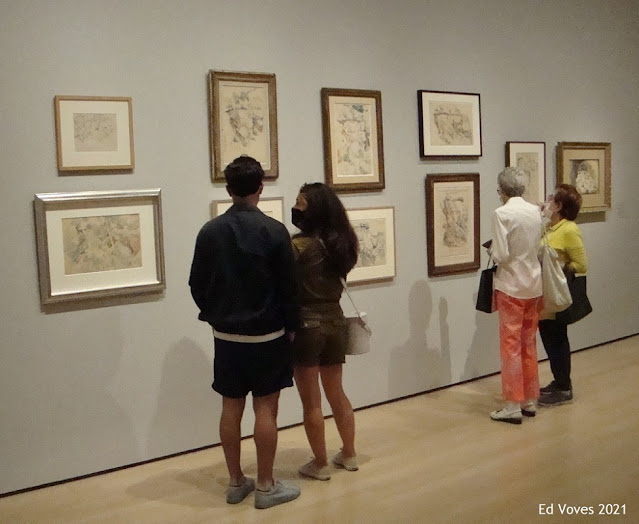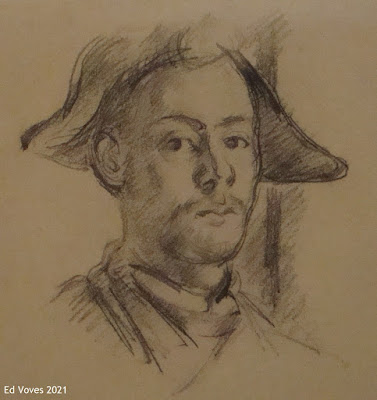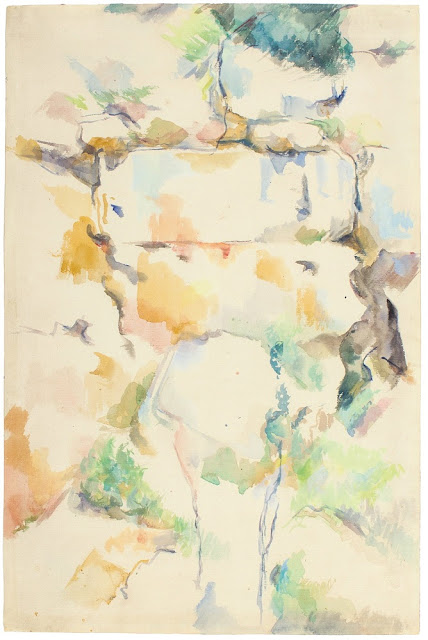Cézanne Drawing
Museum of Modern Art, New York
June 6, 2021 - September 25, 2021
Reviewed by Ed Voves
Paul Cézanne wrote two letters to Emil Bernard which directly relate to the stupendous exhibition currently on view at the Museum of Modern Art in New York City.
Since Cézanne Drawing at MOMA confounds the popular image of Cézanne as primarily a painter rather than a master draftsman, it is worth a few moments to consider the insights he offered to Bernard.
The first letter to Bernard is Cézanne's most famous, dated July 15, 1904. Cézanne counselled Bernard - and through him, a rising generation of artists - "to deal with nature by means of the cylinder, the sphere and the cone, all placed in perspective ..."
This famous advice, however, was not the call to revolution that many consider it. Rather, it was an emphatic affirmation for adhering to the fundamentals of artistic form.
A year later, October 23, 1905, Cézanne again returned to the importance of focusing and observation, of rendering "what we actually see, forgetting everything that appeared before our time." He concluded the letter to Bernard with "a warm hand-clasp and push ahead. The visual sense, as it develops in us by dint of study, teaches us to see."
These profound words, however you interpret them, all point to the pivotal role of drawing for Cézanne. His development as an artist and his sense of human awareness were stimulated by devotion to constant sketching.
Cézanne Drawing at MOMA is a vast exhibition. Over two hundred works of art are on display. The majority are drawings, complemented by an impressive array of watercolors. There are also several oil paintings (chiefly for comparative purposes) on view.
Quite a number of the exhibited works appear in series of similar drawings, many of these with themes rooted in classical art. Cézanne often drew copies of the sculptures in the Louvre, such as Jean-Baptiste Pigalle's marble statue (1744) of Mercury.
The repetition of such traditional images may come as something of a surprise, given Cézanne's reputation. But, as I will comment upon shortly, Cézanne nurtured the flame of the human spirit deep within himself and the works of art in this wonderful exhibition open a portal to his mind and soul.
Cézanne Drawing begins by examining pages filled with multiple drawings, seemingly unrelated in subject. These study sheets, for the most part, were originally bound in the nineteen sketchbooks which Cézanne is known to have used over the course of his career.
Interestingly, Cézanne did not regularly complete a sketchbook and then proceed to a new one, filled with unused pages. Instead, as the spirit moved him, he would refer to older sketchbooks with some open space and fill in the blank area with a new drawing. When I read about this unusual work habit, I smiled to myself that Cézanne's French peasant roots were showing, seeking to make use of every bit of paper.
This, however, was not the case - or a least not all the time. Often, Cézanne was actually creating underlying structure and thematic patterns on his multiple sketch sheets, with intriguing combinations of images. Several of these study sheets include self-portraits which bring us, the viewers, into a dialog with Cézanne and the objects and natural surroundings he is drawing.
Whether this process was the result of Cézanne's conscious decisions or following inner impulses, is a matter of speculation. What can be said is that many of these pages of multiple imagery were not created merely as record of objects and shapes, intended for later use. Instead, these were part of a process, an interaction between Cézanne and the objects he drew.
"Objects penetrate one another," Cézanne told Joachim Gasquet, the noted poet who wrote an early biography of him."They never cease being alive."
This insight is key to understanding Cezanne and his work practice. And, for enabling us to grasp this point, praise and acknowledgment is due to Jodi Hauptman, who organized Cézanne Drawing. The level of curatorial skill which Hauptman devoted to the exhibition is of the highest order. The wall texts accompanying the works of art are hugely rewarding, filled with essential insights.
Cézanne's drawings make for fascinating viewing. Some of these, as noted, deal with related subjects which explain why Cézanne went back and forth filling in empty spaces. A composite sheet from the collection of the Albertina in Vienna, with drawings, front and back, is filled with superb character studies of the artist's young son. Paul.
Before leaping to absolute conclusions about such composite works, it should also be noted that Cézanne sketched a small cooking vessel, a casserole, along with these portraits of young Paul. Perhaps there was an element of humor in these juxtaposed images, or perhaps it was simply a case of Cézanne drawing what interested him.
Another composite, study sheet shows a superb copy of a self-portrait of Francisco Goya, originally used to introduce his "Los Caprichos" illustrations. The same sheet presents a beautifully shaded apple, several figure studies and a glowering self-portrait of Cézanne. If you want a signature sketch for this MOMA exhibition, showing Cézanne's range of mind and drawing ability, this is an excellent choice.
Cézanne's portrait sketches assert a powerful degree of psychological depth which is lacking in some of his portraits-in-oil. This was not due to any lack of ability on Cézanne's part, but rather due to his excruciating slowness as a painter. Several bona fide masterpieces - if they had been completed - testify to that. Cézanne's portait of the art writer, Gustave Geffroy, which was displayed in the National Gallery's 2018 Cézanne exhibiton, is perhaps the most notable example of the artist's over-exactitude.
With his portrait sketches, such as the one he did of his son, dressed for Mardi Gras, Cézanne showed what he was capable of in the realm of character delineation.
Following the trail of Cézanne's work habits, the exhibition also explores the possibility that he created composite oil studies. It is speculated that he then divided the canvases into independent works of art, intended for sale.
A pair of still life paintings, on view in the exhibition, are believed to have been painted on the same canvas and then, carefully cut into separate works. There is a fascinating video detailing this thesis, which MOMA conservators are seeking to confirm with further testing.
Cézanne's still life compositions occupy a prominent place in the exhibition, especially those created with watercolor. With this medium, Cezanne was able to explore the fluid nature of liquid substances, water, wine, even ink, held in containers and displayed on the flat surfaces of his still lives.
Cézanne, by virtue of constant practice, became a master of using blank space in his sketches and still lifes. This enabled him to evoke a sense of solid materiality with a few deft strokes of graphite or traces of pigment on an otherwise unpainted surface. We see this virtuoso ability displayed in the table cloth and white jug in his Still Life with a Blue Pot, one of the "show-stopper" works in the exhibition, on loan from the Getty Museum.
Cézanne did not just make "something out of nothing." He also utilized unworked space or "unfinish" in the figures of the people he sketched.
Paul Cézanne, Hortense Fiquet (Madame Cézanne) Sewing, c. 1880
This is spectacularly evident in the way that Cézanne depicted his wife, intent on her sewing. Her body seems to materialize from the blank area in the center of the drawing. Yet, this is not a void or empty spot. It is rather the very core of the picture, the glowing heart of his wife, Hortense.
The more that you look at Cézanne's sketches, the more you realize that he was attempting to get to the "region of the spirit" of his subjects. His drawings are a record of his feelings, as much as of the objects, people and places he drew.
“I paint as I see, as I feel,” Cézanne announced early in his career, “and I have very strong sensations.”
That these sensations may still be palpable was brought home to me by an incident which occurred during my time in the Cézanne Drawing galleries, I was particularly struck by a two-sided work, executed with pencil and watercolor. On one side (recto), there was an interesting, almost abstract study of a vase of flowers.
When I walked to the other side of the display frame to see the verso, I was stopped in my tracks. The English title of the verso image is Study of Trees, but the original French version does it full justice. Clairière. Clearing.
Clairière. This is the still heart of the forest. Just as the body of the sewing Hortense materializes from the glowing center of the sketch above, so the trees rise up, framing an ethereal woodland clearing. Here one can pause, bask in the sun's rays, listen to the breeze rustling the leaves above. Cézanne has once again made brilliant use of the blank space of the paper to create an almost numinous feeling that God, spirit of the universe, is present.
I could not take my eyes off this stunning work of art. And when I forced myself to go to nearby galleries to see the rest of the exhibit, I kept being drawn back. Finally, after returning a third or fourth time, a fellow art-lover came up and said, "This is one of my favorite Cézannes, too."
"I've never seen it before," I replied. "There's a spiritual quality, here, which I can feel but is hard to describe."
"People say that Cézanne was the least emotional of the Impressionists," the woman sagely noted, "but I think he was the most emotional of them all."
To think of Cézanne in these terms, as an artist with an open-heart, as well as a probing mind, helps us understand just how important drawing was to his life - and to his art. Indeed, it would be almost impossible to separate the two.
Yet, to concentrate entirely on Cézanne's spiritual qualities, runs the risk of neglecting his role as "Father of Modern Art." The MOMA exhibition certainly displays examples of Cézanne's oeuvre which reveal his interest in modern subjects. Geology especially fascinated him and he went to great lengths to incorporate natural forms as the building blocks in his landscape works.
Cézanne's investigation of nature began early in his life. A close school friend, Antoine-Fortuné Marion (1846–1900) later became one of France's greatest geologists. Marion accompanied Cezanne on nature walks and contributed some scientific drawings to his sketchbooks, including a depiction of a trilobite fossil. From these rambles with Marion to the last rain-soaked painting session which led to his death in 1906, Cezanne never stopped observing, drawing and painting the hills of home.
Details of the topography of Provence figure on Cezanne's study sheets and sketchbooks, the result of long hours of study at the Bibémus quarry and of his beloved Mont Sainte-Victoire.
And then there were the trees, majestic groves, studies of roots and branches, masses of leaves. The MOMA wall text notes a contemporary comment which stated that Cézanne "had no real friends except for trees."
Remarks like this fueled the legend of Cézanne the irascible, artist/hermit who had fled the Paris art scene to commune with nature. Cézanne certainly preferred his own company while engaged in art. But it is safer to say that when Cézanne took his backpack of easel, canvas, sketchbook, tubes of paint, pencils and brushes and trudged up toward Mont Sainte-Victoire, he was not trying to escape from the world. Rather, he sought to embrace it with his art.
***
Text: Copyright of Ed Voves, all rights reserved. Cézanne Drawing exhibition images courtesy of the Museum of Modern Art , New York City
Introductory Image: Paul Cézanne (French, 1839-1906) Foliage, 1900–04. Watercolor and pencil on wove paper, 17 5/8 × 22 3/8″ (44.8 × 56.8 cm). The Museum of Modern Art, New York. Lillie P. Bliss Collection. Photo © 2021 MOMA, NY
Ed Voves, Photo (2021) Paul Cézanne's Self-Portrait and Apple, 1880-1884. Pencil on paper: 6 13/16 × 9 1/16" (17.3 × 23 cm) Cincinnati Art Museum.
Ed Voves, Photo (2021) Gallery view of the Cézanne Drawing exhibition at the Museum of Modern Art, New York.
Paul Cézanne (French, 1839-1906) Mercury after Pigalle. c. 1890. Pencil on paper, 15 x 11″ (38.1 x 27.9 cm). The Museum of Modern Art. The Joan and Lester Avnet Fund © 2021 The Museum of Modern Art, Imaging and Visual Resources, photo Peter Butler
Paul Cézanne (French, 1839-1906) Studies of Three Figures, Including a Self-portrait, c. 1876, 1883, 1885 Pencil on laid paper: 19 1/8 × 12 5/8" (48.5 × 32 cm) Museum Boijmans Van Beuningen, Rotterdam.
Ed Voves, Photo (2021) Gallery view of Cézanne Drawing at MOMA, showing two self-portraits.
Paul Cézanne (French, 1839-1906) Studies and Portraits of the Artist's son (recto); Studies, Including a Head and a Small Casserole (verso), 1877-1878 (recto); c. 1878 (verso). Pencil on paper: 9 3/4 × 12 1/8" (24.8 × 30.8 cm) Albertina, Vienna
Ed Voves, Photo (2021) Gallery view of the Cézanne Drawing exhibition, showing a Study Sheet by Paul Cézanne, including a portrait of Francisco Goya (recto), 1877-1880. Pencil on paper: 19 11/16 × 11 13/16" (50 × 30 cm) From a private collection, NY.
Ed Voves, Photo (2021) Detail of Cézanne's drawing, Paul Cézanne Fils as a Harlequin, Studies for Mardi Gras, c. 1888. Pencil on paper: 7 15/16 × 10 11/16" (20.1 × 27.2 cm) Kunstmuseum Basel
Ed Voves, Photo (2021) Gallery view of the Cézanne Drawing exhibition, showing a Cézanne's Glass and Apples, Oil on canvas: 12 3/8 × 15 3/4" inches. Collection Rudolf Staechelin, Basel, and Cézanne's Still Life with Apples, c. 1878. Oil on canvas: 7 1/2 × 10 1/2" (19 × 26.7 cm) Fitzwilliam Museum, Cambridge, UK.
Paul Cézanne (French, 1839-1906) Still Life with Blue Pot, 1900-1906. Pencil and watercolor on paper: 18 15/16 × 24 7/8" (48.1 × 63.2 cm). The J. Paul Getty Museum, Los Angeles.
Paul Cézanne (French, 1839-1906) Hortense Fiquet (Madame Cézanne) Sewing, c. 1880. Pencil on laid paper: 18 9/16 × 12 3/16" (47.2 × 30.9 cm) The Samuel Courtauld Trust, The Courtauld Gallery, London. Princes Gate Bequest
Paul Cézanne (French, 1839-1906) Vase of Flowers (recto), c. 1885-88; Study of Trees (Clairière) (verso), 1887-90. Pencil and watercolor on paper: 18 3/8 × 11 13/16" (46.6 × 30 cm) Fitzwilliam Museum, Cambridge, UK. Bequest of Captain Stanley W. Sykes.
Ed Voves, Photo (2021) Gallery view of the Cézanne Drawing exhibition, showing Cézanne's Study of Trees (Clairière) c. 1885-88.
Paul Cézanne (French, 1839-1906) Rocks Near the Château Noir, 1895-1900. Watercolor on paper. 18 3/16 × 11 15/16″ (46.2 × 30.3 cm). Private collection
Paul Cézanne (French, 1839-1906) Mont Sainte-Victoire, 1902–06. Watercolor and pencil on wove paper: 16 3/4 x 21 3/8″ (42.5 x 54.2 cm). The Museum of Modern Art, New York. Gift of Mr. and Mrs. David Rockefeller. Photo © 2021 MoMA, NY
Ed Voves, Photo (2021) Paul Cézanne's Forest Landscape, 1904-1906. Pencil and watercolor on paper: 18 5/8 × 23 5/8 inches. Private collection
















